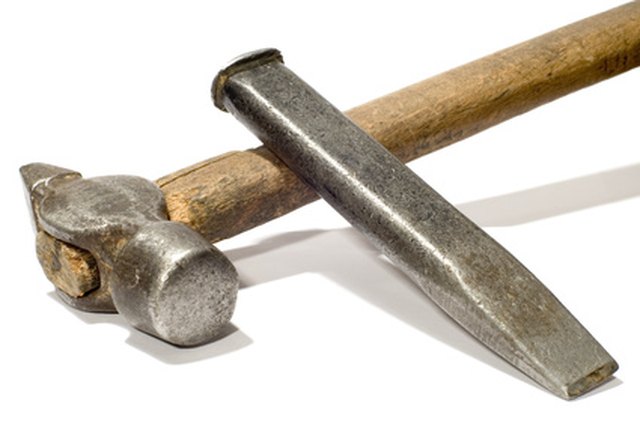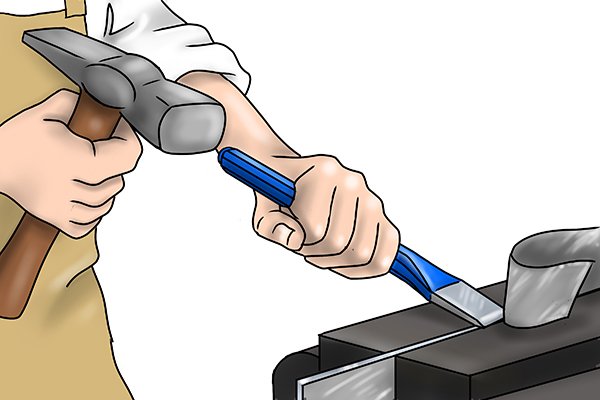Can a cold chisel be used on concrete? If you’ve ever wondered about this, you’ve come to the right place! In this article, we’ll explore whether using a cold chisel on concrete is a viable option. So, whether you’re a budding DIY enthusiast or simply curious, let’s dive in and find out the answer to this question together!
Now, you might be wondering why anyone would want to use a cold chisel on concrete in the first place. Well, sometimes you need to make precise cuts or remove small sections of concrete, and a cold chisel can come in handy for such tasks. But is it the best tool for the job? Let’s find out!
But before we go any further, let’s make sure we’re all on the same page. If you’re not familiar with a cold chisel, it’s a hand tool with a sharp cutting edge, typically made of hardened steel. Traditionally used for shaping and cutting cold metals, it might seem like a logical choice for cutting through concrete. However, there are a few factors to consider before you grab that cold chisel and start chipping away at your concrete surface.
Concrete is a durable material, but can a cold chisel be used on it? Absolutely! A cold chisel is a versatile tool that can be used on various materials, including concrete. Here’s how you can use a cold chisel on concrete:
- Wear safety goggles and gloves for protection.
- Take the cold chisel and position it on the concrete surface.
- Use a hammer to strike the top of the chisel gently.
- Repeat the process, gradually breaking the concrete.
- Take your time and work systematically until you achieve the desired result.
Remember to be cautious and take breaks when needed. Always follow proper safety guidelines when working with tools.

Can a Cold Chisel Be Used on Concrete?
Can a cold chisel be used on concrete? This is a common question among those who are working on DIY projects or tackling home repairs. Cold chisels are typically used for cutting and shaping metal, but can they also be used on concrete? In this article, we will explore the answer to this question and provide you with all the information you need to know about using cold chisels on concrete. Whether you are a seasoned DIY enthusiast or a beginner, understanding the capabilities and limitations of a cold chisel on concrete can help you make informed decisions and achieve successful results.
What is a Cold Chisel?
Before we dive into the question of whether a cold chisel can be used on concrete, let’s start by understanding what exactly a cold chisel is. A cold chisel is a hand tool that is used for cutting, shaping, or carving hard materials, such as metal, stone, or concrete. It consists of a metal blade with a sharp cutting edge and a handle for gripping. The cutting edge is typically at a 60-degree angle and is hardened to withstand the force of striking with a hammer. Cold chisels come in various sizes and shapes, each designed for specific tasks and materials.
Using a Cold Chisel on Concrete: The Pros and Cons
Now that we have a basic understanding of what a cold chisel is, let’s explore whether it can be used on concrete. Using a cold chisel on concrete can have both advantages and disadvantages.
Pros:
1) Precision: Cold chisels allow for precise cutting and shaping on concrete surfaces. They can be used to create clean lines, cut out small sections, or create intricate designs.
2) Versatility: Cold chisels are versatile tools that can be used for multiple purposes. In addition to concrete, they can also be used on other hard materials like stone or brick.
3) Cost-effective: Cold chisels are relatively inexpensive tools, making them a cost-effective option for DIY projects or occasional use.
Cons:
1) Strength and Durability: Concrete is a tough and durable material, and using a cold chisel can be challenging. The force required to cut through concrete can be demanding, and repetitive strikes can cause strain and fatigue.
2) Risk of Chipping: Concrete is prone to chipping when excessive force is applied or when using a cold chisel incorrectly. This can result in uneven surfaces or potential structural damage.
3) Limited Application: While a cold chisel can be used to perform certain tasks on concrete, it may not be suitable for larger-scale projects or heavy-duty applications. In such cases, specialized tools like rotary hammers or jackhammers may be more efficient.
In conclusion, a cold chisel can be used on concrete for certain tasks, but it has its limitations. It is suitable for small-scale projects, precision work, or occasional use. However, for larger projects or heavy-duty applications, it is recommended to use specialized tools designed specifically for concrete. Always exercise caution and follow proper safety guidelines when using any tools, including cold chisels, on concrete or any other materials.”
Key Takeaways: Can a Cold Chisel Be Used on Concrete?
- Yes, a cold chisel can be used on concrete.
- Cold chisels are handy tools for shaping or breaking concrete.
- They have a hardened steel blade for durability.
- Using a cold chisel on concrete requires proper technique and safety precautions.
- Always wear safety goggles and gloves when using a cold chisel on concrete.
Frequently Asked Questions
Welcome to our FAQ section on using a cold chisel on concrete! Below, you’ll find answers to common inquiries related to this topic. Remember, while a cold chisel can be used on concrete, there are important considerations to keep in mind for safety and effectiveness.
1. What is a cold chisel and how does it work on concrete?
A cold chisel is a type of handheld tool typically made of hardened steel or iron. It has a sharp cutting edge and a flat striking surface. When used on concrete, the cold chisel is designed to break the material by applying force with a hammer or mallet. The cutting edge concentrates the energy, allowing you to chip away at the concrete surface.
It’s important to note that using a cold chisel is a manual process that requires physical exertion and precision. It can be effective for small-scale concrete projects or for creating controlled breaks in larger slabs.
2. What safety precautions should I take when using a cold chisel on concrete?
When using a cold chisel on concrete, safety should always be a top priority. Here are some essential precautions to follow:
First, wear protective gear, such as safety goggles, gloves, and a dust mask, to shield yourself from flying debris and any potential respiratory hazards. Additionally, make sure you are working in a well-ventilated area to minimize the inhalation of dust particles.
Furthermore, always use the cold chisel and hammer with caution, keeping your hands at a safe distance from the impact zone to avoid injury. It’s also crucial to secure the material you are working on to prevent slips or accidents. Lastly, if you are a beginner or unsure about the technique, consider seeking guidance from a professional or a knowledgeable individual.
3. Can a cold chisel be used to shape or carve concrete?
While a cold chisel can be used to shape or carve concrete to some extent, it may not be the most efficient tool for intricate or detailed work. The primary purpose of a cold chisel is to break or cut materials, and it excels in tasks like removing stubborn bits of concrete or creating rough edges.
If you are looking for precision and intricate design work with concrete, it may be more suitable to use specialized tools like diamond blades, angle grinders, or power carving tools. These tools offer more control and are specifically designed to shape concrete with greater accuracy.
4. Are there any limitations to using a cold chisel on concrete?
Yes, there are some limitations to keep in mind when using a cold chisel on concrete. Since the cold chisel relies on manual force, it may not be the ideal choice for larger-scale concrete demolition projects or jobs that require significant material removal.
Additionally, using a cold chisel may produce more dust and noise compared to power tools. It requires physical effort and may take longer to complete tasks than using mechanized equipment. It’s important to assess your project’s scale, timeline, and available resources to determine if a cold chisel is the best tool for the job.
5. What are some tips for achieving the best results when using a cold chisel on concrete?
To achieve the best results when using a cold chisel on concrete, consider these helpful tips:
First, ensure that you have selected an appropriate size and shape of cold chisel for your project. A chisel with a wider blade can cover more surface area, while a narrower blade allows for more precise cutting.
Next, mark the area you intend to work on and make shallow grooves or guide lines on the concrete surface. This helps provide guidance and prevents the chisel from slipping or accidentally damaging adjacent areas.
Lastly, use controlled and measured strikes with the hammer to avoid excessive force. Gradually chip away at the concrete, working in small sections and allowing the chisel to do the cutting. Taking your time and using a steady hand will lead to more accurate results and minimize the risk of unintended damage.

Summary
So, can a cold chisel be used on concrete? The answer is no. Cold chisels are not designed for concrete and could break or chip. Concrete requires special tools like rotary hammers or diamond blades.
